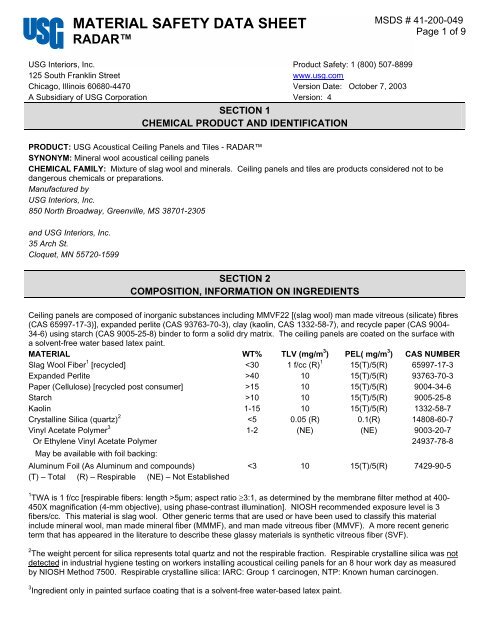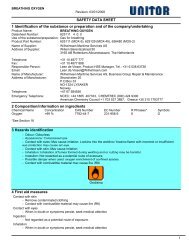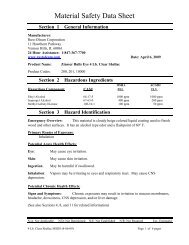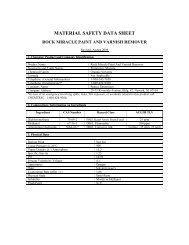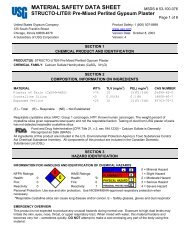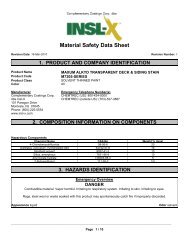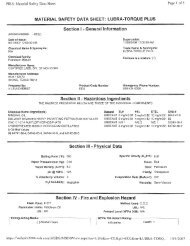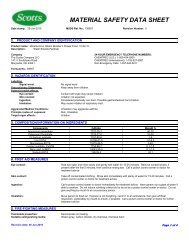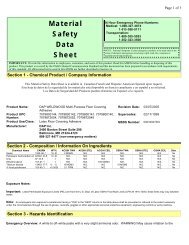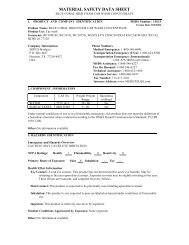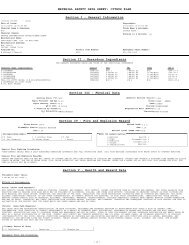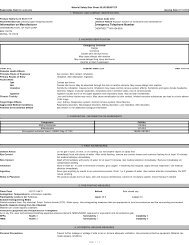USG Acoustical Ceiling Panels and Tiles - RADAR™
USG Acoustical Ceiling Panels and Tiles - RADAR™
USG Acoustical Ceiling Panels and Tiles - RADAR™
You also want an ePaper? Increase the reach of your titles
YUMPU automatically turns print PDFs into web optimized ePapers that Google loves.
MATERIAL SAFETY DATA SHEETRADARMSDS # 41-200-049Page 1 of 9<strong>USG</strong> Interiors, Inc.125 South Franklin StreetChicago, Illinois 60680-4470A Subsidiary of <strong>USG</strong> CorporationSECTION 1CHEMICAL PRODUCT AND IDENTIFICATIONProduct Safety: 1 (800) 507-8899www.usg.comVersion Date: October 7, 2003Version: 4PRODUCT: <strong>USG</strong> <strong>Acoustical</strong> <strong>Ceiling</strong> <strong>Panels</strong> <strong>and</strong> <strong>Tiles</strong> - RADARSYNONYM: Mineral wool acoustical ceiling panelsCHEMICAL FAMILY: Mixture of slag wool <strong>and</strong> minerals. <strong>Ceiling</strong> panels <strong>and</strong> tiles are products considered not to bedangerous chemicals or preparations.Manufactured by<strong>USG</strong> Interiors, Inc.850 North Broadway, Greenville, MS 38701-2305<strong>and</strong> <strong>USG</strong> Interiors, Inc.35 Arch St.Cloquet, MN 55720-1599SECTION 2COMPOSITION, INFORMATION ON INGREDIENTS<strong>Ceiling</strong> panels are composed of inorganic substances including MMVF22 [(slag wool) man made vitreous (silicate) fibres(CAS 65997-17-3)], exp<strong>and</strong>ed perlite (CAS 93763-70-3), clay (kaolin, CAS 1332-58-7), <strong>and</strong> recycle paper (CAS 9004-34-6) using starch (CAS 9005-25-8) binder to form a solid dry matrix. The ceiling panels are coated on the surface witha solvent-free water based latex paint.MATERIAL WT% TLV (mg/m 3 ) PEL( mg/m 3 ) CAS NUMBERSlag Wool Fiber 1 [recycled] 40 10 15(T)/5(R) 93763-70-3Paper (Cellulose) [recycled post consumer] >15 10 15(T)/5(R) 9004-34-6Starch >10 10 15(T)/5(R) 9005-25-8Kaolin 1-15 10 15(T)/5(R) 1332-58-7Crystalline Silica (quartz) 2
MATERIAL SAFETY DATA SHEETRADARMSDS # 41-200-049Page 2 of 9SECTION 2 COMPOSITION, INFORMATION ON INGREDIENTS (continued)This product is a manufactured article <strong>and</strong> therefore exempt from the requirements of Canada’s WHMIS.Food <strong>and</strong> Drug Administration [CFR Title 21, v.3, sec 184.1230] – Calcium Sulfate is Generally Recognizedas Safe (GRAS).All ingredients of this product are included in the U.S. Environmental Protection Agency’s Toxic Substances Control ActChemical Substance Inventory. All components of this product are included in the Canadian Domestic Substances List(DSL).SECTION 3HAZARD IDENTIFICATIONINFORMATION FOR HANDLING AND IDENTIFICATION OF CHEMICAL HAZARDSHEALTH0 = Minimal Hazard*0NFPA Ratings: 0 HIMS Ratings: 1 = Slight HazardFLAMMABILITY 0Health: 0 0 0 Health: *0 2 = Moderate HazardFire: 0 Fire: 0PHYSICAL HAZARD 03 = Serious HazardReactivity: 0 Reactivity: 0 PERSONAL PROTECTION E 4 = Severe HazardPersonal Protection: Use eye protection. Use gloves <strong>and</strong> NIOSH/MSHA-approved respiratory protection when required.*Respirable crystalline silica can cause lung disease <strong>and</strong>/or cancer.EMERGENCY OVERVIEWThis product is not expected to produce any unusual hazards during normal use. Exposure to high dust levels mayirritate the skin, eyes, nose, throat, or upper respiratory tract.Man-made mineral fibres have been classified by the European Union as irritating to skin (R:38).POTENTIAL HEALTH EFFECTSACUTE:The components of acoustical ceiling panels <strong>and</strong> tiles are bound in a cementitious matrix. When panels are cut ortrimmed, especially with power tools, the resulting dust may cause transitory mechanical irritation to skin, eyes orrespiratory tract.Eyes: Airborne dust or direct contact can cause mechanical irritation of eyes. If burning, redness, itching, pain or othersymptoms persist or develop, consult physician.Skin: Direct, prolonged or repeated contact with the skin can cause temporary irritation <strong>and</strong> itchiness. Rubbing of thisproduct against the skin can result in abrasions. If irritation persists, consult a physician.Inhalation: Inhalation of dust can irritate the nose, throat, <strong>and</strong> the upper respiratory tract. Persons subjected to largeamounts of this dust will be forced to leave area because of nuisance conditions such as coughing, sneezing <strong>and</strong> nasalirritation. Labored breathing may occur after excessive inhalation. If respiratory symptoms persist, consult physician.Ingestion: Unlikely to occur, but if ingested may cause temporary irritation to the gastrointestinal tract, especially thethroat <strong>and</strong> stomach.CHRONIC:Inhalation: Prolonged <strong>and</strong> repeated exposure to airborne free respirable crystalline silica can result in lung disease (i.e.,silicosis) <strong>and</strong>/or lung cancer. The development of silicosis may increase the risks of additional health effects. The risk ofdeveloping silicosis is dependent upon the exposure intensity <strong>and</strong> duration. Exposures to respirable crystalline silica arenot expected during the normal use of this product; however, actual levels must be determined by workplace hygienetesting.The concentration of respirable crystalline silica measured in airborne dust samples was below the detection limit usingNIOSH Method 7500 in industrial hygiene testing of workers installing <strong>USG</strong> <strong>Acoustical</strong> <strong>Ceiling</strong> <strong>Panels</strong> for an 8 hour workday.Slag wool fiber has been classified as “not classifiable as to its carcinogenicity to humans” (Group 3) by the InternationalAgency for Research on Cancer (IARC).
MATERIAL SAFETY DATA SHEETRADARMSDS # 41-200-049Page 3 of 9SECTION 3 HAZARD IDENTIFICATION (continued)CHRONIC (continued):Eyes: No known effectsSkin: No known effects.Ingestion: No known effects.TARGET ORGANS: Eyes, skin <strong>and</strong> nose, throat & respiratory system.PRIMARY ROUTES OF ENTRY: Inhalation, eyes <strong>and</strong> skin contact.MEDICAL CONDITIONS WHICH MAY BE AGGRAVATED: Pre-existing upper respiratory <strong>and</strong> lung diseases such as,but not limited to, bronchitis, emphysema <strong>and</strong> asthma. Pre-existing skin diseases such as, but not limited to, rashes <strong>and</strong>dermatitis.SECTION 4FIRST AID MEASURESFIRST AID PROCEDURESEyes: In case of contact, do not rub or scratch your eyes. Dust particles may scratch the eye. Immediately flushthoroughly with water for 15 minutes to remove particulate. If irritation persists, contact a medical professional.Skin: Rinse with cool water <strong>and</strong> then wash with soap <strong>and</strong> warm water. A commercially available skin cream or lotionmay be helpful to treat dry skin areas. If skin has become cracked, take appropriate action to prevent infection <strong>and</strong>promote healing. If irritation or other disorders persist, consult physician.Inhalation: If exposed to excessive levels of dust, leave area of dust exposure to fresh air <strong>and</strong> remain away untilcoughing <strong>and</strong> other symptoms subside. Drink water to clear throat, <strong>and</strong> blow nose to remove dust. Other measures areusually not necessary, however if conditions warrant, contact physician.Ingestion: No harmful effects expected. If ingested, rinse mouth with water to remove particulate. If gastric disturbanceoccurs, call physician.Notes to Physician: This product is a mechanical irritant, <strong>and</strong> is not expected to produce any chronic health effectsfrom acute exposures. Treatment should be directed toward removing the source of irritation with symptomatictreatment as necessary.SECTION 5FIRE FIGHTING MEASURESGeneral Fire Hazards:Not expected to burn.Extinguishing Media:Water or use extinguishing media appropriate for surrounding fire.Special Fire Fighting Procedures: None use normal procedures.Unusual Fire <strong>and</strong> Explosion Hazards: NoneHazardous Combustion Products: Organic material in the panels can produce oxides of carbon.Flash Point: None Known Auto Ignition: Not ApplicableMethod Used:Not ApplicableFlammabilityLimited combustibleUpper Flammable Limit (UFL): Not ApplicableClassification:Lower Flammable Limit (LFL): Not Applicable Rate of Burning: Not Applicable
MATERIAL SAFETY DATA SHEETRADARMSDS # 41-200-049Page 4 of 9SECTION 6ACCIDENTAL RELEASE MEASURESCONTAINMENT:No special precautions. Containment not necessary. Treat as inert material. Keep the spill dry <strong>and</strong> away fromincompatibles (See Section 10). Wear appropriate personal protection (See Section 8). Collect the material fromspillage <strong>and</strong> if not damaged or contaminated by foreign material, ceiling panels may be reclaimed.CLEAN-UP:Use normal clean up procedures. Pick up large pieces. Wear appropriate protective equipment. Use gloves to avoidskin irritation. If dry, shovel or sweep up material from spillage <strong>and</strong> place collected material into a container for recoveryor waste disposal. Avoid dust generation. Avoid inhalation of dust <strong>and</strong> contact with eyes <strong>and</strong> skin. Maintain properventilation. If vacuum is used to collect dust, use an industrial vacuum cleaner with a high efficiency air filter. Ifsweeping is necessary, use dust suppressant such as water. Do not dry sweep dust accumulation or use compressedair for clean up. These procedures will help minimize potential exposures.SECTION 7HANDLING AND STORAGEHANDLING:Avoid dust contact with eyes. Wear the appropriate eye protection against dust (See Section 8).Avoid breathing dust. Wear the appropriate respiratory protection against dust in poorly ventilated areas <strong>and</strong> if TLV isexceeded (see Sections 2 <strong>and</strong> 8).Minimize dust generation <strong>and</strong> accumulation. Use good safety <strong>and</strong> industrial hygiene practices.Follow traditional building practices; such as management of water away form the interior of the structure to avoid thegrowth of mold, mildew <strong>and</strong> fungus. Remove from the jobsite any building products suspected of being exposed tosustained moisture <strong>and</strong> considered conducive to mold growth.STORAGE:Store in a cool, dry, ventilated area away from sources of heat, moisture <strong>and</strong> incompatibilities (see Section 10).Protect from weather <strong>and</strong> prevent exposure to sustained moisture.Protect product from physical damage.SECTION 8EXPOSURE CONTROLS / PERSONAL PROTECTIONENGINEERING CONTROLS:Good general ventilation should be sufficient to control airborne dust levels.If user operations generate airborne dust, use ventilation to keep dust concentrations below permissible exposure limits(See Section 2).Where general ventilation is inadequate, use process enclosures, local exhaust ventilation, or other engineering controlsto control dust levels below permissible exposure limits (see Section 2).Avoid unnecessary exposure to dust <strong>and</strong> h<strong>and</strong>le with care. Keep work area clean of dust <strong>and</strong> fibers by using anindustrial vacuum cleaner with high efficiency filter or wetting down area with water. Never use compressed air <strong>and</strong>avoid dry sweeping.RESPIRATORY PROTECTION:Wear an NIOSH/MSHA-approved respirator equipped with particulate cartridges when dusty in poorly ventilated areas,<strong>and</strong> if TLV is exceeded. A respiratory program that meets OSHA's 29 CFR 1910.134 <strong>and</strong> ANSI Z88.2 requirementsmust be followed whenever workplace conditions warrant a respirator's use. Avoid prolonged <strong>and</strong> repeated breathing ofdust.
MATERIAL SAFETY DATA SHEETRADARMSDS # 41-200-049Page 5 of 9SECTION 8 EXPOSURE CONTROLS / PERSONAL PROTECTION (continued)OTHER PERSONAL PROTECTIVE EQUIPMENT:Eye/Face: Wear eye protection (safety glasses with side shields or goggles) to avoid particulate irritation of the eye.Skin: Gloves or protective clothing are usually not necessary but may be desirable in specific work situations. For briefcontact, no precautions other than clean body-covering clothing should be needed. Wear gloves [chemical gloves arenot necessary, there is no chemical irritation hazard]; a long-sleeved shirt loose fitting at the neck <strong>and</strong> wrists, <strong>and</strong> longpants to prevent repeated or prolonged skin contact. Barrier creams or skin lotion may be applied to face, neck, wrist<strong>and</strong> h<strong>and</strong>s when skin is exposed to help prevent drying of skin. Wash work clothing separately from other clothing.Rinse washer thoroughly after use.General: Selection of Personal Protective Equipment will depend on environmental working conditions <strong>and</strong> operations.SECTION 9PHYSICAL AND CHEMICAL PROPERTIESAppearance White or colored surface; beige/gray core Odor Low to no odorPhysical State Solid pH @ 25 º C ~ 9Vapor Pressure Not applicable Vapor Density (Air = 1) Not applicableBoiling Point Not applicable Vapor Pressure (mm Hg) Not applicableFreezing Point Not applicable Evaporation Rate (BuAc = 1) Not applicableMelting Point 1200ºC (slag wool) Percent Volatile 0Softening Point 700ºC (slag wool) Particle Size Not applicableSolubility (H2O) Very low Molecular Weight Not applicableViscosity Not applicable Bulk Density ~ 250 -400 kg/m 3Specific Gravity (H 2 0 = 1): 2.9SECTION 10CHEMICAL STABILITY AND REACTIVITYSTABILITY:CONDITIONS TO AVOID:INCOMPATIBILITY:HAZARDOUS POLYMERIZATION:HAZARDOUS DECOMPOSITION:Stable.High humidity, moisture, contact with incompatibles.Acids.Will not occur.The decomposition products from this material are those that would be expectedfrom any organic (carbon-containing) material, <strong>and</strong> are mainly derived frompyrolysis (burning) of the organics. These decomposition products may includecarbon monoxide, carbon dioxide, <strong>and</strong> carbon particles.SECTION 11TOXICOLOGICAL INFORMATIONACUTE EFFECTS:Direct contact of dust <strong>and</strong> especially mineral wool fibers with skin can cause eye <strong>and</strong> skin irritation (mechanical) <strong>and</strong>itchiness. Inhalation of dust can cause coughing <strong>and</strong> sneezing due to temporary irritation of nose <strong>and</strong> throat.LD 50: Not Available for product.LC 50 : Not Available for product.
MATERIAL SAFETY DATA SHEETRADARMSDS # 41-200-049Page 6 of 9SECTION 11 TOXICOLOGICAL INFORMATION (continued)CHRONIC EFFECTS / CARCINOGENICITY:Slag Wool Fiber: Large morbidity <strong>and</strong> mortality studies of both European <strong>and</strong> North American mineral woolmanufacturing workers have been conducted. These studies have found no significant association of non-malignant (i.e.fibrosis) or malignant (i.e., lung cancer or mesothelioma) lung disease <strong>and</strong> exposures to slag wool fibers <strong>and</strong> have notestablished a causal relationship between exposure <strong>and</strong> malignant diseases.In 2001, the International Agency for Research on Cancer (IARC) assigned slag wool fiber to the Group 3 category [“notclassifiable as to carcinogenicity to humans”].The synthetic mineral fiber used in this product is exonerated from classification as a carcinogen in accordance withNote Q in the EU Commission Directive 97/69/EC.Industrial hygiene testing on workers installing acoustical ceiling panels for an 8 hour work day showed that the averagerespirable fiber exposure was 0.12 f/cc per NIOSH Method 7400-B.Crystalline silica: Industrial hygiene testing on workers installing <strong>USG</strong> acoustical ceiling panels did not detectrespirable crystalline silica in airborne dust exposures during a regular work day.Prolonged <strong>and</strong> repeated exposure to airborne free respirable crystalline silica can result in lung disease (i.e., silicosis)<strong>and</strong>/or lung cancer. The development of silicosis may increase the risks of additional health effects. The risk ofdeveloping silicosis is dependent upon the exposure intensity <strong>and</strong> duration. Exposures to respirable crystalline silica arenot expected during the normal use of this product; however, actual levels must be determined by workplace hygienetesting.In June 1997, IARC classified crystalline silica (quartz <strong>and</strong> cristobalite) as a human carcinogen. In making the overallevaluation, the IARC Working Group noted that carcinogenicity in humans was not detected in all industrialcircumstances studied. Carcinogenicity may be dependent on inherent characteristics of the crystalline silica or onexternal factors affecting its biological activity or distribution of its polymorphs.IARC states that crystalline silica inhaled in the form of quartz or cristobalite from occupational sources is carcinogenic tohumans (Group 1).SECTION 12ECOLOGICAL INFORMATIONENVIRONMENTAL TOXICITY: This product has no known adverse effect on the ecology. A large discharge directlyinto waterways would not be expected to kill aquatic life. Ecotoxicity Values: Not determined.SECTION 13DISPOSAL CONSIDERATIONSWASTE DISPOSAL:Dispose of material in accordance with Federal, State, Provincial, <strong>and</strong> Local regulations. Consult with environmentalregulatory agencies for guidance on acceptable disposal practices. A local provider of solid waste disposal can assistwith compliance of local code requirements for this building material.SECTION 14TRANSPORT INFORMATIONU.S. DOT INFORMATION: Not a hazardous material per DOT shipping requirements. Not classified or regulated.Shipping NameSame as product name.Hazard Class:Not classifiedUN/NA #:None. Not classified.Packing Group:None.Label (s) Required:Not applicable.GGVSec/MDG-Code:Not classified.
MATERIAL SAFETY DATA SHEETRADARMSDS # 41-200-049Page 7 of 9SECTION 14 TRANSPORT INFORMATION (continued)ICAO/IATA-DGR:RID/ADR:ADNR:Not applicable.NoneNoneSECTION 15REGULATORY INFORMATIONUNITED STATES REGULATIONSAll ingredients of this product are included in the U.S. Environmental Protection Agency’s Toxic Substances Control ActChemical Substance Inventory.MATERIAL WT% 302 304 313CERCLACAASec. 112RCRACodeSlag Wool Fiber 40 NL NL NL NL NL NLRecycled Paper (Cellulose) >15 NL NL NL NL NL NLStarch >10 NL NL NL NL NL NLKaolin 1-15 NL NL NL NL NL NLCrystalline Silica (quartz) 10 Not Listed Not ListedKaolin 1-15 Not Listed Not ListedCrystalline Silica (quartz)
MATERIAL SAFETY DATA SHEETRADARMSDS # 41-200-049Page 8 of 9SECTION 15 REGULATORY INFORMATION (continued)CARCINOGENICITY CLASSIFICATION OF INGREDIENT(S)See Section 11 : Toxicology Information for detailed informationMATERIAL IARC NTP ACGIH CAL- 65Respirable Crystalline Silica 1 1 A2 ListedSlag Wool Fiber 3 2 A3 Not ListedIARC – International Agency for Research on Cancer (World Health Organization)1- Carcinogenic to humans2A – Probably carcinogenic to humans2B – Possibly carcinogenic to humans3 - Not classifiable as a carcinogen4 – Probably not a carcinogenNTP – National Toxicology Program (Health <strong>and</strong> Human Services Dept., Public Health Service, NIH/NIEHS)1- Known to be carcinogen2- Anticipated to be carcinogensACGIH – American Conference of Governmental Industrial HygienistsA1 – Confirmed human carcinogenA2 – Suspected human carcinogenA3 – Animal carcinogenA4 - Not classifiable as a carcinogenA5 – Not suspected as a human carcinogenCAL-65 – California Proposition 65 “Chemicals known to the State of California to Cause Cancer”EUROPEAN REGULATIONSEC ClassificationThis product contains mineral wool [Man made vitreous (silicate) fibres].Danger Symbol: X, IrritantRisk Phrases: Irritating to skin (R:38)Safety Phrases: Wear suitable protective clothing <strong>and</strong> gloves (S36/37).The mineral wool in this product is exonerated from classification as a carcinogen according to Note Q in EUCommission Directive 97/69/EC.Label InformationSECTION 16OTHER INFORMATION∆WARNING!Follow good safety <strong>and</strong> industrial hygiene practices during the h<strong>and</strong>ling <strong>and</strong> installing of all products <strong>and</strong> systems. Dustcreated from product can cause temporary eye, skin, nose, throat or upper respiratory irritation.Avoid creating dust <strong>and</strong> use proper ventilation to reduce dust exposure. Cut <strong>and</strong> trim with razor knife or h<strong>and</strong> saw tominimize dust levels. Using power tools for cutting will generate high dust levels. Power tools must be equipped withdust collection system. Use NIOSH/MSHA-approved dust respirator when exposure limits are exceeded. Avoid dustcontact with eyes <strong>and</strong> skin. Wear eye protection <strong>and</strong> long-sleeve, loose fitting clothing closed at the neck <strong>and</strong> wrists.Wash work clothing separately from other clothing. Rinse washer thoroughly. If eye contact occurs, flush thoroughlywith water for 15 minutes. If irritation persists, call physician. Do not ingest. If ingested, call physician.Product safety information: (800) 507-8899 or www.usg.comKEEP OUT OF REACH OF CHILDREN.
MATERIAL SAFETY DATA SHEETRADARMSDS # 41-200-049Page 9 of 9SECTION 16OTHER INFORMATION (continued)Key/LegendTLVThreshold Limit ValuePELPermissible Exposure LimitCASChemical Abstracts Service (Registry Number)NIOSHNational Institute for Occupational Safety <strong>and</strong> HealthMSHAMine Safety <strong>and</strong> Health AdministrationOSHAOccupational Health <strong>and</strong> Safety AdministrationACGIHAmerican Conference of Governmental Industrial HygienistsIARCInternational Agency for Research on CancerDOTUnited States Department of TransportationEPAUnited States Environmental Protection AgencyNFPANational Fire Protection AssociationHMISHazardous Materials Identification SystemPPEPersonal Protection EquipmentTSCAToxic Substances Control ActDSLCanadian Domestic Substances ListNDSLCanadian Non-Domestic Substances ListSARA Superfund Amendments <strong>and</strong> Reauthorization Act of 1986RCRAResource Conservation <strong>and</strong> Recovery ActCERCLA Comprehensive Environmental Response, Compensation <strong>and</strong> Liability Act of 1980UN/NA#United Nations/North America numberCFRCode of Federal RegulationsWHMISWorkplace Hazardous Material Information SystemPrepared by:Product Safety<strong>USG</strong> Corporation125 South Franklin St.Chicago, Illinois 60606END


